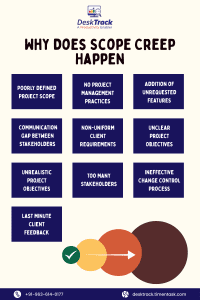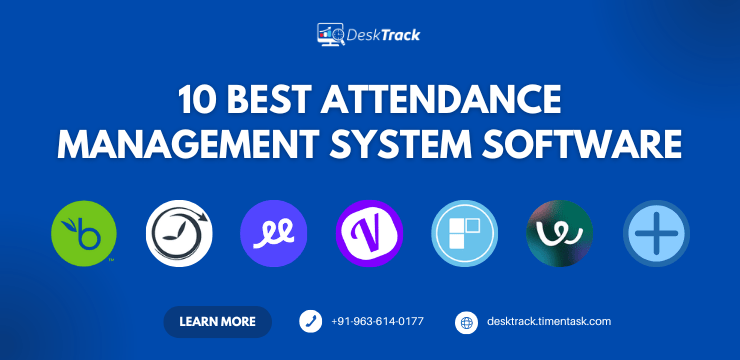
If you are also a project manager like me, you are already familiar with the horrors of scope creep. For starters, it stretches the deadline, impacts scope, increases expenses, de-aligns the teams, and can even mess up the entire workflow if not handled with care. However, it’s not that simple either.
On the bright side, scope creeping can also be beneficial. However, there are only a few pros. Plus, it’s also not to be confused with scope change and scope gap, which I will cover in today’s blog. Overall, I will cover all the useful insights you need to avoid, manage, and prevent this issue.
However, first, you need to wrap your head around the basics of scope creep in project management. With that out of the way, let me get started right away with it.
Scope Creep Meaning in Project Management
Simply put, creep in the scope is a slight deviation of the work from its expected timeline. Why? Obviously, because of the requirement for extra unauthorized, uncalled-for, unexpected change requests. Think of it like the questions at the back of the exam paper that you completely miss. Relatable. Isn’t it? You never wanted it, but still got it. Nonetheless, what begins as a small and manageable change request eventually turns into a pile of requirements, leading to major issues. Here are some examples for a better understanding.
- A 54-week delay in opening a city library being blamed on a substantial number of last-minute changes to the architectural plan.
- The failure to complete the luggage handling system at the Denver airport on time, due to key stakeholders not being consulted promptly, is another example of scope creep. Since their feedback had to be incorporated during execution, it again negatively impacted the project.
Read Also: All You Need to Know About the DuPont Shift Schedule
Why Does Scope Creep Happen?

Now that you know what it is, another concern is the reasons behind project management scope creep. According to my experience, I rounded up 10 of them.
1. Poorly Defined Project Scope
The first one is obvious. It’s the lack of communication between the project manager and clients, or you can say, the manager completely misunderstood the client’s requirements. This leads to a completely different deliverable than what the client may have expected. However, as you all know that it takes two to tango, sometimes you also get to do the most desired thing, which is to blame the client. Especially during creative projects, customers often don’t have a clear vision.
2. No Project Management Practices
For example, if a customer requested a simple change, which you know will only take an hour to make, you will not record it. However, such small things pile up over time and cause delays. Another issue is the practice of managing projects in a decentralized way.
3. Addition of Unrequested Features
At times, your teams might start adding additional features to impress the clients. However, this is only taking your chances because it may or may not match the upcoming client demands. It wastes time and causes delays, especially when the deadline is tight. This means that you either underperformed on the major requirements or will have no time to complete them.
4. Communication Gap Between Stakeholders
Another issue leading to unauthorized changes in the project’s objectives is the lack of communication between the stakeholders. The reality is that:
- Clients often don’t reply immediately to phone calls and emails.
- Sometimes the project runs into an unexpected obstacle. So, there is no need for scope expansion.
- Without any input from the clients, any decisions fall on the teams only. The customers might not like these unapproved changes.
5. Non-Uniform Client Requirements
As you already know, too many chefs spoil the broth. This applies to ongoing projects as well. For example, if the client has appointed multiple people at different points of the project, there will be different visions, which will confuse. Another bad case is when multiple team members have decision-making powers.
6. Unclear Project Objectives
Having unclear project goals leads to teams not knowing what work to prioritize. Overall, they will end up working on tasks that don’t contribute anything to the project’s success.
7. Unrealistic Project Objectives
Scope creep or failure can also happen due to the project goals being unachievable. That is, the teams can’t complete the work within the given time frame. Remember that when the project goals and boundaries are not aligned from the start, managing project scope creep becomes next to impossible.
8. Too Many Stakeholders
This one is straightforward. If there is no project manager, or you can say, project owner, your work and scope can mess up pretty badly.
9. Ineffective Change Control Process
These include changing a foundational or crucial element of a project. However, if you are simply letting stakeholders make the changes, then you will be doomed for sure.
10. Last Minute Client Feedback
If you are not proactively collecting customer feedback, the possibility of scope creeping becomes higher. That’s because you will get change requests and feedback when you are about to deliver. What it does is change the goals, intent, scope, and timeline of your project. The issue involves changing what you are doing or starting over with new features and needs.
Why is Project Scope Creep Not Good?
Scope creep in project management causes some major issues, including:
- Lack of communication
- Lack of experience in project scope
- Poor goal setting
Can Scope Creep Also Be Good for Your Business?
So far, what you know about the scope creep definition only makes it clear that it’s a major issue. However, there are a few situations where it can work in your favor as well.
1. Improved Client Retention
Complying with change requests translates to turning every stone to turn the client’s vision into a reality. This leads to improved market reputation for you, increases your client base, and ensures that your previous customers sign contracts for new projects with you only.
2. Ensures Market Compatibility
Frequent updates in the features ensure that your final product stacks up well to the market requirements. However, it’s essential to know that these changes must match the project constraints and also reflect in the updated deadline and budget.
3. Revenue Skyrockets
This part works when you are charging your clients on a per-hour or per-deliverable basis. Here, change requests mean revenue boosts.
4. Optimized Team Processes
An upshift in your project’s objectives can also unlock learning objectives for your teams. For instance, you can reduce scope creeping in the future by streamlining your internal processes.
Why You Need to Proactively Address Scope Creep
Quickly addressing and avoiding scope creep is critical. Otherwise:
- It can lead to significant expense overruns
- It can cause a breakdown in team communication
- It can lead to inefficiencies in time management in the team
- It can cause burnout in the time quicker than an employee makes up an excuse to take time off.
- It can lead to a lack of transparency over final deliverables
Scope Creep Vs. Scope Change Vs. Scope Gap
Scope creep, change, and gap in project management are 3 different elements of a project, not to be used interchangeably. Although these are quite similar, there are still major differences that all project managers need to understand.
|
It’s a consistent but unauthorized change in the project’s scope. Due dates and budgets are inappropriately changed. |
|
The customer and boss officially agree upon changing the project’s scope, adding new features, or expanding functionalities. |
|
It happens when the team’s and the client’s understanding of the scope don’t align. |
Read Also: The Critical Path Method in Project Management: Your Full CPM Guide
How to Avoid & Manage Scope Creep?

That was all about the scope creep meaning and how it affects projects. However, can you and I do anything to prevent or manage it? Of course. Here are 5 simple measures you need to follow.
1. Be Proactive
Involve all the stakeholders from the project plan to the execution for 100% transparency. To understand the client’s vision, you need to request that they provide you with a project charter and a feature list.
2. Prioritize Your Tasks
Coming up with a list of critical tasks that must be completed to finish the project. That is, you need a priority list. Plus, by prioritizing tasks, you can also keep your teams in check by preventing them from wasting hours and hours by concentrating on unimportant tasks.
3. Put a Price On It
One way to decrease the amount of change requests is to invoice for them. Plus, it will also add to the revenue. Another thing you can do is get the new feature in place of another existing one in the charter. This keeps the time and resources needed constant.
4. Use Technology
You can use project management software to boost team performance. Nonetheless, modern projects can’t be completed without the help of technology. If you are thinking about them, spreadsheets will only make the job harder than it already is. So, no.
5. Learn to Say No
Lastly, to prevent scope creep in project management, simply say no to it. For instance, explain to the client how certain change requests can impact the project. I am sure that this will convert it to a scope change.
Additional Tips to Fix Scope Creep in Project Management
If the first 5 methods don’t work for you, here are some other expert tips to prevent scope creep from turning into a nightmare.
- In case the collaborators force new prototypes, communicate to them the project range, with what’s possible and what’s not. It might help your teams realign with the project requirements.
- If the above doesn’t work, implementing a change control process wouldn’t do you any harm. All you have to do is ask the requester to submit their changes via your setup. The next step is to involve your stakeholders in the request reviews and decide whether altering the scope is worth it.
- In case the changes are accepted, you must de-prioritize another deliverable. A good idea is to make room for this new work by cutting or delaying anything, if possible.
- If de-prioritization is not possible, the only option left now is to utilize your resources to reach your goals. That is, if any are available.
Benefits of Preventing Scope Creep in Project Management
If there is no scope creeping, then the opportunity to gain several advantages is unlocked. Here’s what I mean.
- There is a better probability of providing the clients with quality work within the given time frame.
- You have more time for focused work during the workflow. This makes you more productive and happier while you work.
- High-quality deliverables satisfy your clients. That’s only possible if there is no scope creep.
How to Manage Project Scope?
When project changes are requested without your agreement or knowledge, they are known as scope creep. On the other hand, there will be documented changes to the project requirements. Whatever the case, you need a change control process, which involves:
- Monitoring the project’s baseline scope and status.
- Comparing actual work performance measurements with the baseline scope using variance analysis.
- Determining the cause and degree of the changes found.
- Deciding whether to correct or prevent change requests.
- Handling all variation requests and suggested actions through the integrated change control process.
If the approved change requests affect the project’s overall scope and cost baseline, you must update and send the scope statement, work breakdown structure, and cost baseline to all the stakeholders.
DeskTrack: The Project Management Software for Stopping Scope Creep
With DeskTrack’s project management software, there will be no need to prevent scope creep because there won’t be any. With its real-time workspace, workflow, task, list, sub-task, and checklist management, you will feel like you are there with your team all the time and know what’s and what’s not during the workflow. Identifying and preventing time wastage becomes simple, and so does work management. Plus, clients can easily communicate the changes via the Slack integration and can even create their own tasks for your teams to work on, adding new features without causing unnecessary delays. DeskTrack not only effectively manages projects and streamlines workflows, but it also maximizes the productivity of your employees.
Frequently Asked Questions (FAQ)
Q. What is Scope Creep in Project Management?
Ans. Simply put, scope creep is a subtle deviation of the project from its original scope. What begins as a small and manageable change request eventually turns into a pile of requirements, leading to major issues.
Q. Why Does Scope Creep Happen?
Ans. These are the reasons for it.
- Poorly Defined Project Scope
- No Project Management Practices
- Addition of Unrequested Features
- Communication Gap Between Stakeholders
- Non-Uniform Client Requirements
- Unclear Project Objectives
- Unrealistic Project Objectives
- Too Many Stakeholders
- Ineffective Change Control Process
- Last Minute Client Feedback
Q. Why is Project Scope Creep Not Good?
Ans. Scope creep in project management causes some major issues, including:
- Lack of communication
- Lack of experience in project scope
- Poor goal setting
Q. Why Do You Need to Proactively Address Scope Creep?
Ans. Quickly addressing and avoiding scope creep is critical. Otherwise:
- It can lead to significant expense overruns
- It can cause a breakdown in team communication
- It can lead to inefficiencies in time management in the team
- It can cause burnout in the time quicker than an employee makes up an excuse to take time off.
- It can lead to a lack of clarity over final deliverables.
Q. How to Avoid & Manage Scope Creep?
Ans. You need these measures.
- Be Proactive
- Prioritize Your Tasks
- Put a Price On It
- Use Technology
- Learn to Say No










